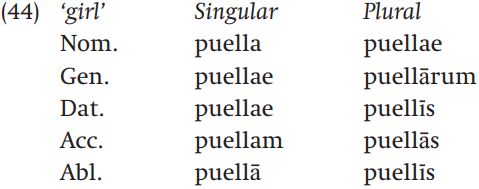
The fourfold classification
 المؤلف:
Rochelle Lieber
المؤلف:
Rochelle Lieber
 المصدر:
Introducing Morphology
المصدر:
Introducing Morphology
 الجزء والصفحة:
132-7
الجزء والصفحة:
132-7
 24-1-2022
24-1-2022
 1844
1844
The fourfold classification
Morphological typology has a long history, going back at least to the early nineteenth century in the work of Wilhelm von Humboldt (1836; reference in Comrie 1981/1989). In this tradition, also developed by the linguist Edward Sapir, who we mentioned above, it was common to divide languages into four morphological types: isolating (or analytic), agglutinative, fusional, and polysynthetic.
An isolating or analytic language is one in which each word consists of one and only one morpheme. Vietnamese is often cited as an example of an isolating language. For example, nouns do not inflect for plurality. The noun dông h ̓ ô ̓ means ‘watch’ or ‘watches’. If one wants to be specific about how many watches are in question, it is possible to use a numeral and then a noun classifier before the noun (Nguyen and Jorden 1969: 119), as (41a) shows:

Similarly, as (41b) illustrates, verbs do not inflect for tense in Vietnamese. Instead, if one wants to be specific about the time of an event, it is necessary to use specific adverbs like ‘tomorrow’ or ‘yesterday’.
Of the languages we have profiled in section 7.3, Mandarin comes closest to being an isolating language. Although Mandarin has abundant compounding, it has little that would count as morphological inflection. Like Vietnamese, plurality, tense, and aspect are all expressed by separate words
Unlike isolating languages, agglutinative languages have complex words. Furthermore, those words are easily segmented into separate morphemes and each morpheme carries a single chunk of meaning. In our grammatical sketches in 7.3, Turkish is the language that comes closest to an agglutinative ideal. For example, we gave the various case forms of the Turkish noun ‘house’ in (10), repeated here (42):

To form the plurals of these nouns, all one needs to do is add the morpheme -ler, which goes after the root and before the case endings:

The two sorts of morphemes are easily separated in terms of both form and meaning.
A fusional language, like an agglutinative language, allows complex words, but its morphemes are not necessarily easily segmentable: several meanings may be packed into each morpheme, and sometimes it may be hard to decide where one morpheme ends and another one starts. Latin is a good example of a fusional language. We can, for example, compare the noun paradigm in Latin with that in Turkish. Whereas it is easy in Turkish to separate off one morpheme that means ‘plural’ and another that means ‘genitive’, it is not possible find separate morphemes that go with those concepts in Latin. Let’s look again at the paradigm for ‘girl’ in Latin in example (27), repeated here:

If we assume that the root for the noun ‘girl’ is puell, the best we can do is to say that the morpheme that means genitive singular is -ae and the one that means genitive plural is -ārum. Each of these also carries gender information (remember that nouns with these endings are most often feminine) as well. But there is no way of separating part of these morphemes into smaller pieces that mean ‘genitive’ or ‘singular’ or ‘plural’ or ‘feminine’). This is the hallmark of fusional morphology.
The final morphological type is called polysynthetic. In a polysynthetic language words are frequently extremely complex, consisting of many morphemes, some of which have meanings that are typically expressed by separate lexemes in other languages. In our grammatical sketches in section 7.3, Nishnaabemwin is a language that could easily be characterized as polysynthetic. Remember that it not only has an intricate inflectional system, but forms complex words out of two or more bound bases.
Here is an illustration of polysynthesis (Valentine 2001: 330, 334):

These forms can then act as bases for all the inflectional affixes that attach to intransitive verbs in Nishnaabemwin.
 الاكثر قراءة في Morphology
الاكثر قراءة في Morphology
 اخر الاخبار
اخر الاخبار
اخبار العتبة العباسية المقدسة


